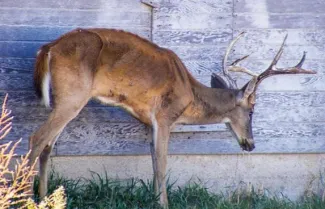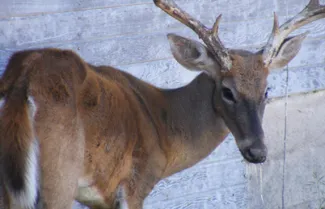What is Chronic Wasting Disease?
Oklahoma deer hunters may have heard about Chronic Wasting Disease (CWD) afflicting deer and elk in other states. CWD is a neurological disease that affects the brains of deer, elk, moose, and other members of the deer family, creating holes that resemble those in sponges. It is always fatal to the animal, and no treatment or vaccine against CWD exists at this time. CWD has been confirmed in wild deer and/or elk in Oklahoma and surrounding states including Texas, New Mexico, Colorado, Kansas, Missouri, and Arkansas.


CWD in Oklahoma
In 1998, CWD was confirmed in a captive elk herd in Oklahoma County which had originally been imported from Montana. The U.S. Department of Agriculture euthanized that herd to decrease the threat of the disease spreading into the surrounding free-ranging deer herd. Subsequent testing outside of the enclosure did not locate any positive animals. In April 2019, CWD was confirmed in one farmed Oklahoma elk in Lincoln County. ODWC announced it would step up surveillance in areas adjacent to the breeding facility.
In 2022, the Wildlife Department was notified by the Texas Parks & Wildlife Department (TPWD) of a road-killed deer infected with chronic wasting disease (CWD) found 2.5 miles south of the Oklahoma-Texas border near Felt, Okla., in southwestern Cimarron County. With the proximity of this infected deer to Oklahoma's border, ODWC activated its CWD Response Strategy. This includes the designation of Selective Surveillance Areas (SSA).
Go to Selective Surveillance Areas (SSA)
In 2023, Oklahoma's first case of CWD was confirmed in a free-ranging wild deer in Texas County. ODWC has conducted CWD monitoring on hunter-harvested deer and road-killed deer and elk since 1999. This case marks the first time the disease has been detected in laboratory testing of tissue samples from more than 10,000 wild deer and elk throughout Oklahoma.
ODWC takes disease issues very seriously because of the potential effects on the state’s rich hunting traditions, human health concerns, the risk to natural resources, and the $1.2 billion impact hunting has on our state's economy annually. ODWC’s primary objective is to minimize the risk to Oklahoma's wild deer, elk, and other susceptible cervids within our borders.
ODWC is reviewing and updating its response strategy in response to new scientific research and the disease's closer proximity to our state. ODWC is also coordinating with the Oklahoma Department of Agriculture, Food and Forestry, and other agencies to monitor the state’s captive cervid herds and provide information to the public as it becomes available.
Importation of Cervid Carcasses or Carcass Parts
No person shall import, transport, or possess any cervid carcass or part of a cervid carcass from outside the boundaries of Oklahoma. The following items are the only exceptions:
- Antlers or antlers attached to clean skull plate or cleaned skulls (all tissue removed);
- Animal quarters containing no spinal materials, or meat with all parts of the spinal column removed;
- Cleaned teeth;
- Finished taxidermy products;
- Hides or tanned products;
- Harvested deer, elk or other cervidae if they are going to a taxidermist in good standing with the Secretary of State
ODWC continues to monitor and test for the presence of CWD. A total of 79 wild deer were sampled and tested for CWD in conjunction with the 2017 herd health evaluations. CWD was not detected in any of the samples. Most recently, as part of the 2018 herd health evaluations, 42 samples were collected and submitted to Colorado State University for testing. None of those samples tested positive for the disease. Testing is expected to continue into future years.
CWD was first detected in captive mule deer in Colorado in 1967. It is a slow-progressing disease with a long time lag between becoming infected and showing outward symptoms. Infected animals begin to lose weight, lose their appetite and develop an insatiable thirst. They tend to separate from their herds, walk in repetitive patterns, stumble or tremble, carry their head low, salivate, urinate frequently, and grind their teeth.
The disease spreads when animals are in close contact, but also when animals contact soil that contains prions (protein particles) from urine, feces, saliva, or an infected animal’s carcass.
CWD transmission to humans or livestock has not been documented. However, the U.S. Centers for Disease Control and Prevention recommends, as a precaution, that people or animals do not eat any part of an animal diagnosed with or showing signs of CWD.
